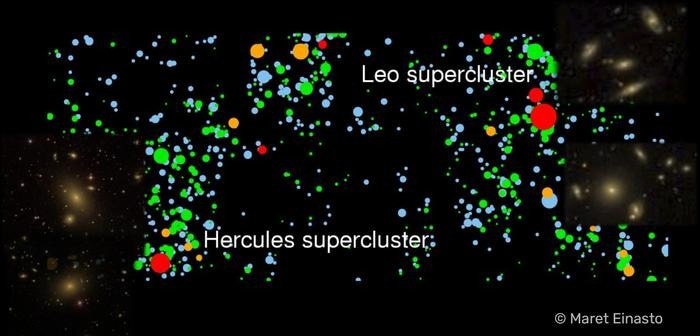Reviewed by Lexie CornerFeb 28 2024
Astronomers generally agree that the primary distinction between galaxy groups and clusters is the number of galaxies within each; in other words, groups contain a higher number of galaxies than clusters.
 Each colored circle depicts a galaxy group or cluster. The richest galaxy clusters are marked in red, the richest galaxy clusters in the Hercules and Leo superclusters. The side panels show the brightest galaxies of these clusters from the Sloan Digital Database. The yellow, green, and blue circles represent galaxy groups from the brightest to the faintest. Image Credit: Maret Einasto
Each colored circle depicts a galaxy group or cluster. The richest galaxy clusters are marked in red, the richest galaxy clusters in the Hercules and Leo superclusters. The side panels show the brightest galaxies of these clusters from the Sloan Digital Database. The yellow, green, and blue circles represent galaxy groups from the brightest to the faintest. Image Credit: Maret Einasto
Astronomers from the Tartu Observatory at the University of Tartu, led by Maret Einasto, chose to investigate that and found more distinctions between groups and clusters.
It is possible to think of the universe's organization as a massive network, a cosmic web of rich galaxy groups and clusters that can contain hundreds of galaxies connected by chains (filaments) of individual galaxies and tiny groups of galaxies.
Mass gaps with essentially no observable matter (gas and galaxies) exist between galaxy systems. Superclusters, which are much larger systems, can be formed by the union of galaxy groups and clusters.
Astronomers at Tartu used information on galaxy groupings, their nearest and brightest galaxies (known as main galaxies), and their environments in their study. Combining these data was done to determine whether it may yield any fresh insights into the potential classification of various group sizes.
The research revealed two distinct galaxy groupings and clusters, each with unique characteristics. Rich and poor groups have different physical mechanisms influencing the birth and evolution of the major galaxies in groups and clusters.
Researchers used two distinct approaches to characterize the groups' environments in their work. Using superclusters as the biggest high-density regions and voids as the largest low-density regions, they first explained the cosmic web in terms of the general density field. Second, they determined each galaxy group's distance from the closest filament axis. This distance indicates whether the group is within, outside, or in the middle of a filament.
Researchers separated the primary galaxies of galaxy groups into two categories: those with active star formation and those without, which are primarily red in color and have young stars contributing to their blue hue. Among the primary galaxies in the groupings, they also discovered red star-forming galaxies.
When the properties of the main galaxies in groups of varying luminosity (or richness) were compared, it was discovered that groups can be divided into two main classes: low-luminosity poor groups, which may include blue or red star-forming galaxies in addition to those with no active star formation, and high-luminosity groups and clusters, where nearly all of the main galaxies are non-star-forming red galaxies.
Not only does brightness distinguish groups and clusters, but each sample can be split in half according to a single attribute. It was also discovered that all high-luminosity galaxy clusters and groupings are situated in filaments in high-density areas. Supercluster filaments contain all of the richest and brightest clusters.
On the other hand, low-luminosity galaxy clusters and individual galaxies are dispersed throughout the cosmic web, even in low-density areas like voids, isolated filaments, and even considerable distances from filaments. It is interesting to note that within superclusters, impoverished galaxy groups with the same number of members have substantially higher luminosities than those outside of superclusters.
The research reveals contrasting dynamical characteristics between rich groups containing main galaxies that have ceased star formation and those with actively star-forming main galaxies. Notably, main galaxies in the former tend to cluster near the group or cluster center, whereas star-forming main galaxies tend to be located farther away from the group center.
Scientists discovered that, in the case of extremely rich clusters, particularly in clusters with non-star-forming main galaxies, the relationship between the group velocity dispersions and the stellar velocity dispersions of main galaxies—known from earlier studies—does not hold true.
One of the main goals of cosmology is to characterize the characteristics of the universe's structure and the processes by which it forms and changes. The findings broaden the knowledge of how galaxy clusters and groups form, how they have evolved, and how the primary galaxies inside them fit into the cosmic web.
Rich galaxy clusters arise only in areas with a high enough overall density of matter and an abundance of gas required for star formation. Other (equally affluent) groups and clusters can affiliate with rich clusters in these areas. Few mergers occur in low-density zones (the now vacant areas) because only relatively impoverished groupings that are spread out can form.
The study's findings also imply that rich and poor groups have distinct physical mechanisms driving the birth and evolution of the major galaxies in groups and clusters. Processes in and around their dark matter haloes dominate the evolution of individual galaxies and primary galaxies in small groups. The influence of other galaxies and more distant environs (galaxy group mergers, for example) is significant, particularly in rich clusters.
The research further highlighted the significance of galaxy superclusters as a distinct setting for the genesis and development of galaxies and galactic systems.
The next stage for the working group will be to check the new observational data, including information on very faint galaxies, in their studies on galaxies and galaxy groupings. The Tartu Observatory takes part in these initiatives.
Journal Reference:
Einasto, M., et al. (2024) Galaxy groups and clusters and their brightest galaxies within the cosmic web. Astronomy & Astrophysics. doi.org/10.1051/0004-6361/202347504.